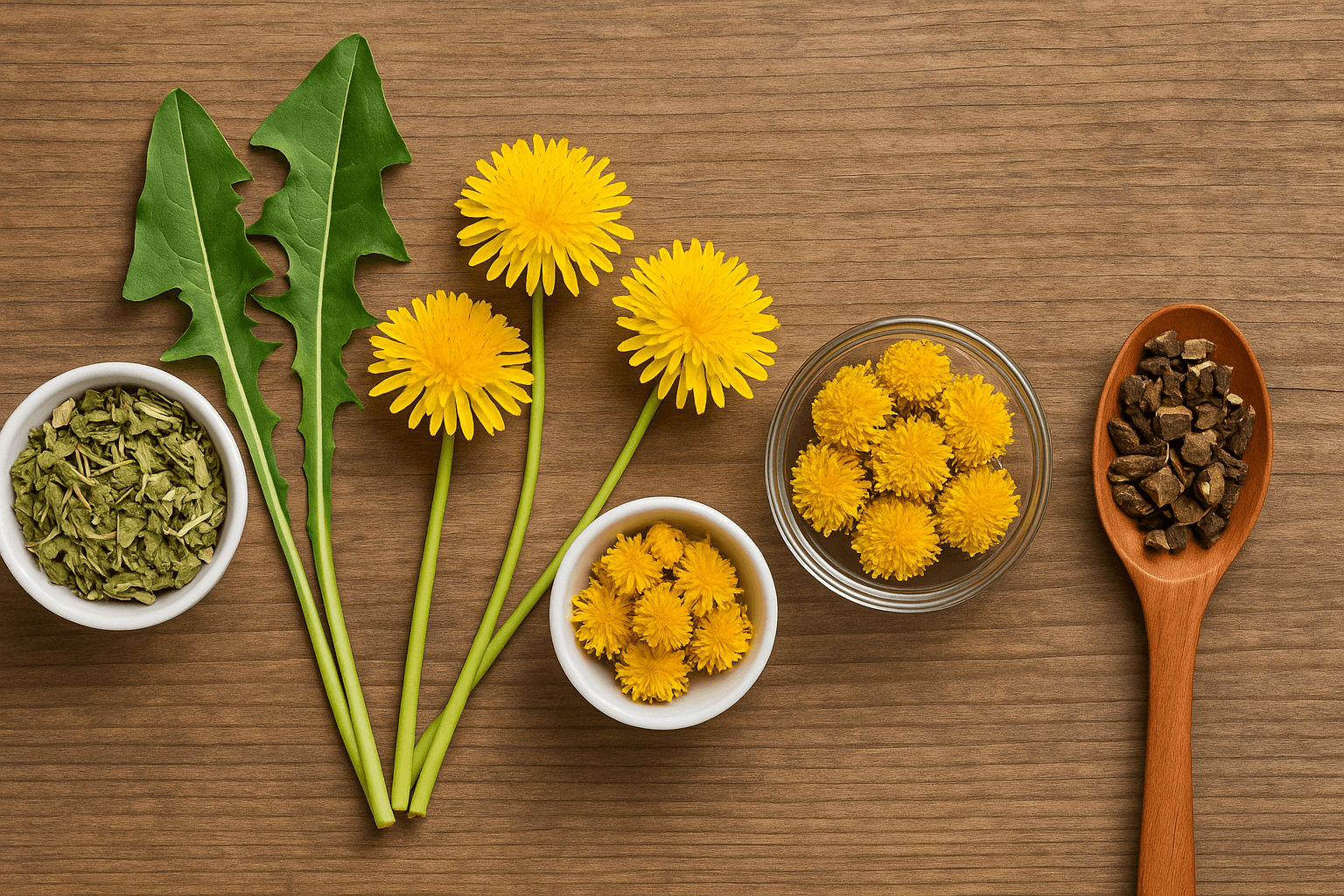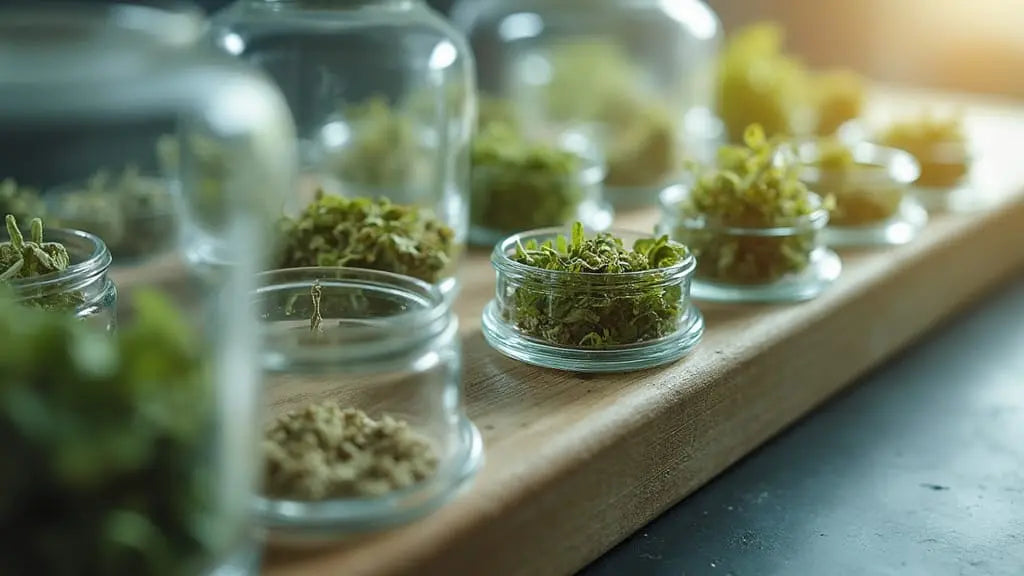The Whole-Plant Philosophy & Dandelion
In a world obsessed with isolating the “most potent” part of a plant, we’ve lost something essential: The wisdom of the whole. At Sacred Plant Co, we believe in restoring that balance, honoring the complete botanical expression of each herb, not just its headline compounds.

Dandelion (Taraxacum officinale) is a masterclass in this whole-plant power. Its leaves, flowers, and roots aren’t simply different parts of the same plant, they’re distinct medicinal forces, each offering a unique constellation of benefits. The leaves are mineral-rich and alkalizing, the flowers deliver antioxidant support and gentle mood uplift, and the roots nourish the liver and microbiome with inulin and other prebiotics.
Used together, these parts don’t just add up, they multiply in effect. That’s because many of the compounds in dandelion work synergistically: Fat-soluble vitamins in the leaves improve the body’s ability to absorb the flavonoids in the flowers. The prebiotic compounds in the root fuel beneficial gut bacteria, which in turn enhance absorption and immune modulation across the whole system.
When you consume the entire plant, you’re tapping into nature’s intended delivery system. It’s not just holistic. It’s efficient, bioavailable, and time-tested.
This is the core of what we mean by whole-plant herbalism, a commitment not just to healing, but to harmony, and dandelion, often overlooked as a weed, offers one of the clearest and most powerful examples of why that matters.
Dandelion: Botanical Snapshot of Active Compounds
Dandelion (Taraxacum officinale) isn’t just one herb, it’s three complementary medicines in a single plant. Each part, from leaf to flower to root, contains its own unique balance of active compounds, and when used together, they offer a full-spectrum approach to wellness that modern extracts often miss.
The Leaves
Dandelion leaves are nutritional powerhouses. Rich in vitamins A, C, and K, they also contain calcium, magnesium, potassium, and trace minerals that nourish the body at a cellular level. Their bitter compounds, known as sesquiterpene lactones, stimulate bile production, a process crucial for digestion, detoxification, and nutrient absorption. You’ll also find chicoric acid here, a polyphenol known for its role in modulating immune response and supporting healthy blood sugar levels. Get Yours Now
The Flowers
Bright and golden, dandelion flowers are packed with antioxidant flavonoids like luteolin and chlorogenic acid. These compounds help combat oxidative stress, a silent contributor to aging, inflammation, and chronic disease. Traditionally, the flowers have also been used topically to calm irritated skin, and their mild flavor makes them ideal for uplifting herbal teas that soothe both the body and the mind. Get Yours Now
The Roots
Beneath the soil, dandelion roots concentrate a completely different set of gifts. Most notable is inulin — a prebiotic fiber that feeds beneficial gut bacteria and supports healthy digestion. The roots also contain taraxasterol and related triterpenes, which have been studied for their liver-supportive and anti-inflammatory properties. When roasted, the root transforms into a deliciously earthy beverage that offers many of the benefits of coffee without the crash. Get Your Now
Why This Matters
These compounds don’t work in isolation. The flavonoids in the flowers are better absorbed when paired with the fat-soluble nutrients in the leaves. The inulin in the root feeds the very gut flora responsible for converting plant compounds into active, health-promoting metabolites. This kind of synergy is only available when we use the whole plant, exactly as nature designed it.
A Storied History Across Continents: The Herbal Legacy of Dandelion

Dandelion (Taraxacum officinale) may be dismissed by many as a common weed, but its roots — both literal and cultural — run deep across centuries of traditional medicine. Across Europe, Asia, and the Americas, herbalists turned to the entire plant: leaf, flower, and root. Its universal presence and remarkable therapeutic profile earned it a place not just in gardens, but in the foundations of folk healing systems around the world.
Medieval European Herbalism: Leaf & Root Spring Tonics
In pre-industrial Europe, dandelion was seen as a symbol of survival and spring renewal. During the early months of the growing season, after long winters without fresh greens, dandelion leaves became an essential mineral source for replenishing the body’s stores of calcium, potassium, and vitamin C.
Monastic and village healers crafted bitter brews from the leaves and roots to “stimulate the humors” — a medieval way of describing liver detoxification and bowel regularity. These spring tonics helped purge the stagnation of cold months, supporting blood purification and digestive vitality. Leaf and root were often used together to create a balanced, whole-body cleanse.
Traditional Chinese Medicine: Pu Gong Ying and Internal Heat
In Traditional Chinese Medicine (TCM), dandelion has been classified for centuries as a cooling herb that clears “heat and toxins” from the liver, blood, and skin. Known as Pu Gong Ying, it is frequently prescribed for clearing inflammatory conditions — from acne and boils to liver stagnation and eye redness.
The entire aerial plant — including flowers — is often decocted with other liver-cleansing herbs to reduce systemic inflammation. Practitioners also recognize dandelion's bitter flavor as essential for promoting bile flow and digestive efficiency, foundational concepts in both Eastern and Western herbal traditions.
Indigenous North American Traditions: Flower Salves & Root Tonics

For many Indigenous tribes in North America, dandelion was embraced as both food and medicine. The leaves were consumed fresh or boiled to restore strength after illness, while the roasted root was prepared as a grounding tea or a coffee substitute — especially during leaner months when energy was scarce.
Notably, dandelion flowers were often infused into animal fats or oils to create topical salves. These were applied to sunburn, wind-chapped skin, and muscle aches — showcasing an intuitive understanding of the flower’s anti-inflammatory and skin-supporting qualities. The use of the whole plant was fluid, seasonal, and purpose-driven.
The Global Pattern: Harmony Through the Whole Plant
Despite cultural and geographic distance, a shared wisdom emerged: the full dandelion plant works better than its parts alone. Ancient herbalists didn’t isolate compounds — they worked with synergy. Leaves for their minerals and alkalinity. Roots for prebiotic depth and liver support. Flowers for antioxidants and emotional lightness.
Today, science is only beginning to validate what traditional medicine already knew — that plants like dandelion, in their full botanical expression, offer unmatched therapeutic value. At Sacred Plant Co, we carry this legacy forward with reverence, crafting small-batch, whole-plant offerings that honor the past while grounding you in the present.
Dandelion Leaf: Mineral-Rich and Metabolically Intelligent
The leaves of the dandelion plant are among the most undervalued yet nutrient-dense greens in the herbal world. Deeply bitter and wildly alkaline, dandelion leaf (Taraxacum officinale folium) has been a cornerstone of herbal medicine for centuries, especially in traditions that emphasize detoxification, digestion, and fluid balance.
A Nutritional Powerhouse Disguised as a “Weed”

Each dandelion leaf is a living mineral matrix. Rich in potassium, calcium, magnesium, and iron, the leaves also contain high levels of vitamins A, C, and K. But the real stars are its phytochemicals: chicoric acid, chlorogenic acid, and sesquiterpene lactones, which activate detoxification pathways, improve insulin sensitivity, and stimulate bile production for more efficient digestion.
In fact, dandelion leaf contains more calcium and iron than spinach, and its potassium levels rival that of bananas, making it one of the best herbs for restoring mineral balance after stress, poor diet, or dehydration.
Traditional and Modern Uses
-
As a Natural Diuretic: The high potassium content makes dandelion leaf a unique diuretic — one that helps the body release excess water without depleting electrolytes. This sets it apart from pharmaceutical diuretics, which can leave the body vulnerable to imbalance.
-
For Liver & Gallbladder Support: Bitter compounds stimulate bile flow, supporting fat digestion and promoting daily detox through the liver and intestines.
-
For Inflammation & Blood Sugar Balance: Chicoric and chlorogenic acids have shown promising anti-inflammatory and glucose-regulating effects in modern studies, suggesting dandelion may help buffer metabolic stress.
How to Use Dandelion Leaf (and Why It Matters)
Dandelion leaves are best enjoyed close to their natural form to retain delicate nutrients and bitter complexity.
For Tea: Steep 1–2 teaspoons of dried leaf in hot water for 5–10 minutes. Add lemon for enhanced flavor and mineral absorption.
In Food: Use rehydrated or fresh leaves in salads, pestos, or soups. Their bitterness pairs beautifully with citrus, garlic, and olive oil.
For Detox: Combine with dandelion root in a morning infusion to encourage gentle daily elimination and support liver drainage.
Why Each Step Matters:
-
Steeping too long can result in excessive bitterness and degrade vitamin C.
-
Pairing with acidic ingredients (like vinegar or lemon) improves the uptake of minerals like calcium and magnesium.
-
Drinking leaf tea before meals helps stimulate digestion and prevent sluggishness after eating.
Sustainably Harvested, Carefully Dried
At Sacred Plant Co, we hand-harvest our dandelion leaves in the early morning, when mineral uptake is highest. They’re gently dried to preserve volatile compounds and maintain the leaf’s integrity with no nutrient loss.
Explore Our Premium Dried Dandelion Leaves: wild-grown, lab-verified, and ready to support your body’s natural systems.
Dandelion Flower: The Bright Heart of the Plant

The dandelion flower is more than just a golden burst of sunshine — it’s a potent herbal ally, packed with antioxidants, gentle anti-inflammatories, and skin-loving compounds. While often overshadowed by the better-known root and leaf, the flower offers an entirely different spectrum of benefits. At Sacred Plant Co, we treat this part of the plant with reverence, hand-selecting only the most vibrant blooms at peak potency and preserving them with meticulous care.
A Delicate Harvest
Our dandelion flowers are gathered by hand during their short blooming window, early in the day while their antioxidant content is highest. We harvest only the fully opened, undamaged blossoms — no stems, no green bracts, and immediately begin the slow drying process under shade to preserve the flower’s volatile oils and rich golden color.
This isn’t a mass-harvested, tumbled-in-a-machine product. Every flower in your bag was chosen by human hands, inspected for quality, and dried with the same precision you’d use in your home apothecary.
What Makes the Flower So Special?
Unlike the bitter leaf and deep-rooted earthiness of the root, dandelion flowers are light, slightly sweet, and energetically uplifting. They contain powerful compounds like luteolin, chlorogenic acid, and a spectrum of polyphenols known for their role in fighting oxidative stress and soothing inflamed tissues.
Top Benefits:
-
Cellular Protection: Luteolin and other flavonoids act as scavengers of free radicals, helping to reduce oxidative damage across cells and tissues.
-
Skin Health: Traditionally infused into oils or salves, dandelion flower helps calm inflamed, sun-damaged, or dry skin.
-
Mood & Nervous System Support: The gentle energy of the flower, in tea or infusion form, is traditionally used to lift heaviness and promote a sense of mental clarity and lightness.
How to Use Dandelion Flower
Dandelion Flower Tea: Steep 1–2 teaspoons of dried petals in hot (but not boiling) water for 5–7 minutes. The result is a sunny yellow tea with a subtle floral flavor — caffeine-free, mineral-rich, and perfect for afternoon sipping.
For Skincare: Infuse the dried flowers in a carrier oil like jojoba or sweet almond for 2–4 weeks, strain, and use as a base for facial oils or muscle salves. The infusion is especially helpful for dry, sensitive, or sun-exposed skin.
In Food: Sprinkle petals over salads, infuse in honey, or incorporate into baked goods for both color and a mild botanical complexity.
Our Promise: Purity You Can See
You’ll notice it immediately — our dried dandelion flowers are brilliant yellow, with petals intact and free from filler or debris. There’s no dust, no stem fragments, no dull browning. That’s the difference of slow drying, small-batch work, and unwavering attention to quality.
Premium Dried Dandelion Flowers — 100% Natural, Hand-Harvested
Harvested with intention. Dried with precision. Packaged for potency.
Dandelion Root: Deep Detox, Deeper Nourishment

Beneath the surface, dandelion root runs thick, fibrous, and quietly powerful — carrying a legacy of liver support, digestive restoration, and prebiotic nourishment. While the flower and leaf reach upward, the root grounds the plant in earth, drawing in minerals and storing healing compounds throughout the growing season. It’s no surprise traditional healers around the world have revered it as a cornerstone of internal cleansing and resilience.
At Sacred Plant Co, we harvest dandelion roots at their peak — in the cool seasons, when inulin concentrations are highest. We wash and slice each root by hand, then dry it slowly and thoroughly to preserve its deep earthy scent and subtle sweetness. Nothing is over-processed or overheated. Just soil, steel blades, patience, and the reverence this ancient herb deserves.
Why Dandelion Root Works
Inulin-Rich Prebiotic Support:
Up to 40% of dandelion root’s dry weight is inulin — a type of soluble fiber that feeds beneficial gut bacteria like Bifidobacterium and Lactobacillus. This makes dandelion root a powerful ally for anyone looking to improve digestion, reduce bloating, or support immune function via the gut microbiome.
Liver and Gallbladder Function:
Dandelion root is a classic “bitter.” Its taraxasterol content gently stimulates bile flow, which helps the liver process fats, toxins, and hormones more efficiently. Daily use of dandelion root tea can support gentle, ongoing detoxification — without aggressive purging or dependency.
Blood Sugar and Anti-Inflammatory Benefits:
Modern studies show that compounds like chicoric acid and taraxasterol may support healthy blood sugar levels and reduce inflammation through antioxidant pathways. This helps regulate energy and stress responses, making dandelion root a subtle but steady metabolic supporter.
How to Use Dandelion Root
Daily Decoction (for Liver & Gut):
Simmer 1–2 teaspoons of dried root in 2 cups of water for 15–20 minutes. Drink warm or cool. Add ginger or cinnamon if desired. Use daily for best results — this is a slow, foundational healer.
Roasted Root “Coffee” (for Energy Without the Crash):
Roast dried root in the oven at 325°F until dark and fragrant (about 15–20 minutes). Brew as you would coffee — rich, nutty, caffeine-free, and kind to your adrenals. Bonus: it supports digestion instead of irritating it.
Tincture or Powder:
Blend root powder into smoothies or capsules for more potent, on-the-go liver and gut support. Dandelion root is also a common component in herbal bitters formulas.
Rooted in Craftsmanship
Our roots are harvested in small batches, washed by hand, and never subjected to high-speed processing. This means you’ll see whole root pieces — not dust. You’ll smell the difference the moment you open the bag: rich, clean, and deeply grounding.
Explore Our Premium Dried Dandelion Root — wild-grown, slow-prepared, and ready for your daily ritual.
Safety, Interactions & FAQs

Dandelion has a long and well-established history of safe use in herbal medicine. But just because it’s gentle doesn’t mean it should be taken without care. As with any potent botanical, understanding how and when to use it — and when to avoid it — makes all the difference in harnessing its benefits.
Is Dandelion Safe for Daily Use?
Yes, for most people, dandelion is safe and well-tolerated when consumed in moderate amounts over time. It’s a food-grade herb, often eaten fresh in salads or brewed into tea, and has been used across cultures as a daily tonic for centuries.
In fact, many herbalists recommend dandelion root or leaf tea as part of a regular wellness routine for gentle digestive and liver support.
Are There Any Side Effects?
While uncommon, some people may experience:
-
Mild digestive stimulation (e.g., increased urination or bowel movements)
-
Allergic reactions, particularly if sensitive to plants in the Asteraceae family (e.g., ragweed, chamomile, marigold)
-
Upset stomach, especially if consumed in excess or on an empty stomach
If you’ve never used dandelion before, it’s best to start with a small serving and observe how your body responds.
Can Dandelion Interact with Medications?
Yes, though rare, interactions are possible. The most common concerns include:
-
Diuretics: Dandelion leaf has natural diuretic properties. If you’re already on a water pill, taking dandelion may increase fluid loss or impact electrolyte balance.
-
Lithium: Dandelion may alter how the body clears lithium, potentially affecting blood levels.
-
Blood Sugar or Blood Pressure Medications: Dandelion can modestly lower both, which may enhance the effects of these drugs.
-
CYP450 Substrates: Dandelion may mildly influence liver enzyme activity, potentially affecting how some medications are metabolized.
If you're taking prescription medications or managing a chronic condition, always consult your healthcare provider before starting dandelion as a supplement or tea.
How Much Should I Take?
There’s no single “correct” dose, but traditional herbal guidelines suggest:
-
Dandelion Leaf Tea: 1–2 tsp dried leaf per cup, 1–3 cups per day
-
Dandelion Flower Tea: 1–2 tsp dried flower per cup, as desired
-
Dandelion Root Decoction: 1–2 tsp dried root simmered in water daily
-
Roasted Root Beverage: Brew like coffee — up to 2 cups per day is common
Listen to your body. Some people thrive on daily use; others prefer a few times per week during seasonal transitions or periods of stagnation.
Is It Safe During Pregnancy or Breastfeeding?
Dandelion has been used traditionally during pregnancy, especially in the third trimester to support fluid balance and reduce swelling. However, research is limited, and safety in pregnancy and lactation hasn’t been firmly established in modern clinical trials.
If you’re pregnant, nursing, or trying to conceive, consult a qualified herbalist or your healthcare provider before using dandelion regularly.
Even the gentlest herbs deserve respect. At Sacred Plant Co, we believe that empowerment begins with information, and when used wisely, dandelion becomes more than a detox herb. It becomes part of your relationship with your own body’s intelligence.





